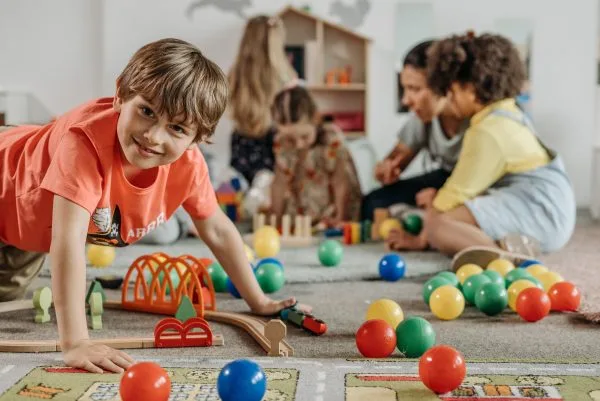Figuring out how to get kids to clean up can often feel like solving a puzzle, but it becomes much more straightforward with the proper techniques. Teaching kids the importance of tidying up is not just about maintaining a neat home; it’s about instilling a sense of responsibility and discipline.
Studies have proven time and time again that chores are crucial for a child’s development and success. Research from a well-known 75-year Harvard study explored psychosocial variables and biological processes in childhood that could predict health and well-being in later life. Researchers concluded that children who were assigned chores not only developed essential life skills earlier, but also tended to fare better in various aspects of adulthood. Other studies have found that giving children chores boosts confidence and self-esteem, as well as increases autonomy and independence later in life.
As a parent, you want only the best for your child. While sometimes it may seem impossible, you can motivate your children to take responsibility and participate in cleaning activities with the right strategies. In this article, we’ll explore why kids may need more time to tidy up and provide you with 10 actionable tips to encourage a cleaner lifestyle.
Why Do Kids Resist Cleaning?
At the heart of the matter is understanding why children resist cleaning. Children are still developing their organizational skills and often need help determining where to begin.
The task can appear overwhelming. Additionally, play and exploration are the natural inclinations of children. Interrupting these activities for a chore can seem punitive and less rewarding. Children also value their time and might view cleaning as an imposition, especially if it isn’t presented as a necessary and beneficial activity.
However, watching a kid cleaning rooms instills a sense of pride in them and teaches responsibility. However, understanding the psychology behind their reluctance can help address the root cause.
10 Tips to Encourage Kids to Clean Up
While every child is unique in their task approach, using a few universal techniques to foster a positive attitude toward cleaning. The trick is tapping into their innate curiosity and love for play.
These strategies transform what is perceived as a chore into an engaging learning opportunity. From games to positive reinforcements, here are 10 tried-and-tested tips to show you how to get kids to clean up.
1. Clean Up the House Game
Transforming clean-up time into a fun activity can be effective. Incorporating a clean up the house game can turn tidy time into an exciting action for kids. Make cleanup a competitive or timed game to create a fun environment encouraging participation. Design a game where each toy or item is a “character” that needs to return to its “home.”
Goodnight, Toys: Inspired by the story “Goodnight, Moon,” guide children to bid their toys goodnight and put them in their rightful places. This game emphasizes the importance of returning items to designated spots each evening.
I Spy Cleanup: This is a fun way to teach children about colors, shapes, and object recognition. Direct them with prompts like “I spy a pair of dirty pants on the floor!” or “I spy three blue things,” guiding them to pick up specific items.
Beat The Parent: Try a competitive game where kids try to complete their cleaning tasks faster than the parent. Perfect for times when parents are busy with their chores, this game keeps kids engaged and helps them stay focused on their tasks.
2. Age-Appropriate Tasks
Regular kid-cleaning sessions teach children the importance of maintaining a neat environment. Ensure that the tasks you assign are suitable for your child’s age. That way, you can even get the baby cleaning up. Younger children can start with simple tasks like putting toys in a box, while older kids can take on more responsibilities like dusting or vacuuming.
Toddlers (1-3 years):
- Picking up toys: Teach them to place toys back in their designated spots after playing.
- Wiping spills: Hand them a cloth to clean up minor spills, emphasizing gentle wiping.
- Putting dirty clothes in a hamper: Make it a routine to have them place clothes in the laundry bin.
- Dusting low surfaces: Provide a child-friendly duster to let them help with reachable areas.
Preschoolers (4-6 years):
- Making the bed: Introduce basic skills like straightening blankets and fluffing pillows.
- Clearing the table: Guide them to safely remove dishes and utensils after meals.
- Watering plants: They can assist with keeping indoor plants hydrated by using a small watering can.
- Sorting laundry: Teach colors by letting them sort clothes into whites, colors, and darks.
Elementary School Age (7-9 years):
- Sweeping: Equip them with a child-sized broom to sweep up crumbs or dirt.
- Setting the table: Make them responsible for laying out dishes, utensils, and meal napkins.
- Emptying trash bins: Ensure they understand how to replace bin liners correctly.
- Helping with pet care: Filling water bowls, feeding, or brushing pets are fun tasks at this age.
3. Consistency is Key
Parents often wonder how to get their child to clean their rooms without a fuss, and the secret lies in consistency and positive reinforcement. Establish a routine. If kids know that every evening before dinner is tidy-up time, they’ll be more prepared and accepting of the task.
Scheduled Clean-Up: Set a specific time each day for clean-up. For example, every day at 5 pm can be dedicated to ‘cleaning time,’ so kids get into the rhythm of tidying up.
Reminder Alarms: Use alarm reminders to signal the start of cleaning time. The consistent audio cue helps children mentally prepare for the task ahead.
4. Use Music and Songs
Urging a toddler to clean up toys can be made more appealing by turning it into a song or game, and they often respond well to musical cues. Play a catchy clean-up song. Dancing and singing along can make the activity feel less like a chore and more like a party.
Create a Clean-Up Playlist: Curate a short playlist of fun and energetic songs exclusively for clean-up time. Over time, when these songs play, kids will associate them with cleaning.
Invent a Clean-Up Song: Collaborate with your kids to create a catchy clean-up song. Singing it together can make the activity memorable and enjoyable.
5. Visual Reminders
Use charts or visual aids that showcase clean-up activities for preschoolers. That can serve as a consistent reminder for them to tidy up after themselves.
Chore Charts: Designate a wall or area for a chore chart, where kids can place stickers or mark tasks as they complete them daily.
Color-Coded Bins: Use different colored bins for toys, books, and clothes. Attach a visual aid, like a picture, to each compartment, making it easier for kids to identify where items belong.
6. Make It a Group Activity
Cleaning can be more fun when done collectively. Having all the children cleaning up together makes the task more enjoyable and promotes teamwork.
Rotate Group Leaders: Assign a different child as the weekly cleaning leader. The designated child can delegate tasks and ensure everything gets done.
Cleaning Challenges: Set up team-based cleaning challenges, where kids form teams and compete to see which group can clean up the fastest or most efficiently.
7. Provide Proper Storage
For kids cleaning up toys, designated storage boxes or bins make the task more straightforward and organized. When every item has its place, cleaning becomes more systematic.
Label Storage Spaces: Clearly label storage boxes or bins. Whether it’s for LEGOs, dolls, or books, knowing where each item goes can streamline the process.
Storage Accessibility: Ensure that storage solutions are easily accessible. Lower shelves for younger kids and higher ones for older children can make self-cleaning easier.
8. Set a Timer
Create a sense of urgency. Challenge your kids to finish their tasks before the timer goes off. It’s like a mini clean up the house game where kids race against the clock.
Progress Check-Ins: Halfway through the timer, do a quick check-in. Praise the progress they’ve made and encourage them to finish strong.
Timer Variations: Occasionally change the timer’s duration to keep it fresh and exciting, sometimes making it a quick sprint or a longer marathon.
9. Reward System
Consider introducing a rewards chart. Positive reinforcement can go a long way. Rewarding the kid cleaning a room will reinforce that behavior. Additionally, if a child wants to tidy up common areas, create a system where they can earn points or stars. After a certain number of points, they will get a reward.
Tiered Rewards: Establish different reward levels. For instance, 10 stars could earn a small treat, while 30 stars might warrant a more significant reward.
Special Chore Days: Introduce surprise chore days where tasks come with double stars or points, making it an exciting opportunity to earn rewards faster.
10. Lead by Example
Children who see you cleaning up are likely to emulate the behavior. Be the role model they need.
Joint Cleaning Sessions: Dedicate a time when you and your child clean side by side. You can clean the bookshelf while they take care of their toys.
Narrate Your Process: As you clean, explain why and how you’re doing it. This way, kids understand the reasoning and learn the importance of each task.
The Role of an Au Pair in Teaching Clean-Up Habits
An au pair can be a pivotal figure in instilling clean-up habits in children. They might have different clean-up activities for preschoolers or strategies on how to get your child to clean their room from their upbringing or culture.
Their consistent presence ensures the strategies are maintained, and their fresh approach can introduce kids to different methods of organization and tidiness. Plus, with the bond they develop with the children, their encouragement can carry significant weight.
Trust Go Au Pair with All Your Child’s Needs
Learning how to get kids to clean up is more than maintaining a tidy home. It’s about instilling discipline, responsibility, and organizational skills to benefit them in the long run.
With the right strategies, you can make this task fun and rewarding. And remember, an au pair can be an invaluable asset in this journey, bringing unique techniques and a consistent approach.
To discover how Go Au Pair can help meet all your child’s needs and learn more about the benefits of having an au pair, visit our Au Pair page.



